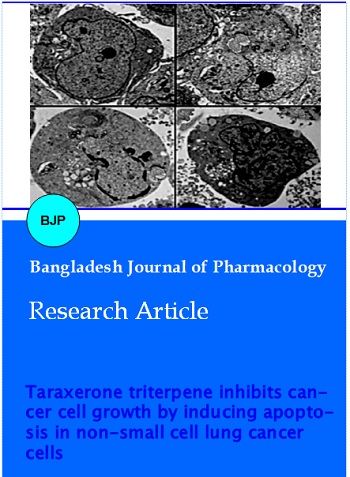Taraxerone triterpene inhibits cancer cell growth by inducing apoptosis in non-small cell lung cancer cells
DOI:
https://doi.org/10.3329/bjp.v11i2.24338Keywords:
Apoptosis, Cancer cell, Non-small cell lung cancer cell, Taraxerone triterpeneAbstract
The objective of the present study was to evaluate the anti-cancer effects of taraxerone in non-small cell lung cancer cells (A-549). The effect of this compound on apoptosis and cellular morphology was also studied. MTT (3-(4, 5-dimethylthiazol-2-yl)-2, 5-diphenyltetrazolium bromide) assay was used to evaluate the effect of the compound on cell viability. Cellular morphology after taraxerone treatment was demonstrated by fluorescence microscopy and transmission electron microscopy. The results revealed that taraxerone induced dose-dependent as well as time-dependent growth inhibitory effects on A-549 cell line showing an IC50 value of 53.2 and 61.6 µM at 24 hours and 48 hours time intervals respectively. It also inhibited cancer cell colony formation in a dose-dependent manner and around 90% of the cancer cells were destroyed by the 125 µM dose of taraxerone treatment. Taraxerone also induced cell shrinkage, chromatin condensation and nuclear membrane rupture which are characteristic of apoptosis.
Downloads
396
250 Read
227

Published
How to Cite
Issue
Section
License
Authors who publish with this journal agree to the following terms:
- Authors retain copyright and grant the journal right of first publication with the work simultaneously licensed under a Creative Commons Attribution License that allows others to share the work with an acknowledgement of the work's authorship and initial publication in this journal.
- Authors are able to enter into separate, additional contractual arrangements for the non-exclusive distribution of the journal's published version of the work (e.g., post it to an institutional repository or publish it in a book), with an acknowledgement of its initial publication in this journal.
- Authors are permitted and encouraged to post their work online (e.g., in institutional repositories or on their website) prior to and during the submission process, as it can lead to productive exchanges, as well as earlier and greater citation of published work (See The Effect of Open Access).
